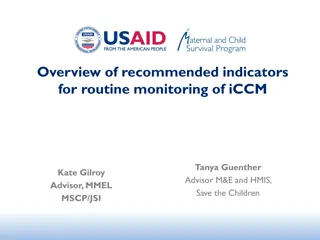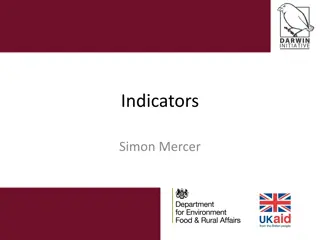Understanding Indicators in Strategic Planning and Information Management
Explore the importance of indicators in monitoring and evaluation, learn about different types of indicators such as baseline, output, and outcome. Discover the qualities of a good indicator and the various forms they can take, from direct to qualitative and standardized global indicators versus locally developed ones.
Download Presentation

Please find below an Image/Link to download the presentation.
The content on the website is provided AS IS for your information and personal use only. It may not be sold, licensed, or shared on other websites without obtaining consent from the author. Download presentation by click this link. If you encounter any issues during the download, it is possible that the publisher has removed the file from their server.
E N D
Presentation Transcript
3.3 Strategic Planning & IM Tools 3.3 Strategic Planning & IM Tools Part 2: M&E Framework Part 2: M&E Framework INFORMATION MANAGEMENT Registered Charity No 1079752 RedR UK is a company limited by guarantee. Company Number 3929653
Indicators An indicator is a measure that is used to show change in a situation, or the progress in/results of an activity, project, or programme. Indicators: enable us to be watchdogs ; are essential instruments for monitoring and evaluation. are objectively verifiable measurements
Common terminology Baseline indicators measure the baseline or current situation e.g. numbers of participation for women and men from different age. Process indicators measure how the delivery of goods and/or services is done. These indicators can be used for individual project monitoring (not in the HRP), e.g. the numbers of women and men staff to provide services Output indicators measure the delivery of goods and/or services to a targeted population. (not in the HRP), numbers of women and girls participation in reproductive health services Outcome indicators are the likely or the achieved short-term and medium-term effects of an intervention s outputs. usually used in HRPs, e.g. % of women and girls have improved nutrition situation
What are the qualities of a good indicator? Specific Measurable Achievable Relevant Time-bound The Sphere Project provides the most accepted indicators for nutrition and food security interventions in emergencies: see Module 21. And there is also the SMART initiative . Standardised Monitoring and Assessment in Relief and Transition Initiative - interagency initiative to improve the M&E of humanitarian assistance
Types of indicators Indicators exist in many different forms: Examples? Direct indicators correspond precisely to results at any performance level. Direct Indirect / proxy Indirect or "proxy" indicators demonstrate the change or results if direct measures are not feasible. Indicators are usually quantitative measures, expressed as percentage or share, as a rate, etc. Quantitative Qualitative Indicators may also be qualitative observations (e.g. Changes in gender roles within the HH food consumption). Standardised global indicators are comparable in all settings. Global / standardised Locally developed Other indicators tend to be context specific and must be developed locally.
Malnutrition rates amongst young children reduced Impact Related to Goal % of young children getting appropriate complementary food Related to Objectives (or Purposes) Outcome X number of mothers know about good complementary food and how to prepare that Related to results Output of activities Nutritional education to mothers on complementary food Related to Activities/Resources Input
What is a Log Frame? The logical framework or logframe is an analytical tool used to plan, monitor, and evaluate projects. We use a results-based approach ? ? ? Victim of a log frame? ?
IMPACT OUTCOME Results-based approach INPUTS
Results-based approach for M&E Project description Indicators Source / means of verification Assumptions / risks If the OBJECTIVES are produced, then this should contribute to the overall GOAL Goal If OUTPUTS/RESULTS are produced, then the OBJECTIVES are accomplished Objectives / outcomes If adequate ACTIVITIES are conducted, then OUTPUT/RESULTS can be produced Deliverable outputs Activities If adequate RESOURCES/INPUTS are provided; then activities can be conducted
Activities versus Results Completed activities are not results. e.g. a hospital was built, does not mean that injured and sick people can be treated in the hospital, maybe the hospital has no water and the beds have not been delivered. Service providers behaviour are gender insensitive or safety issues for women and girls, in particular are poor. Results are the actual benefits or effects of completed activities: e.g. Injured and sick people have access to a fully functional health facility. Increased number of women and girls from reproductive age availed services and or, increased number of GBV cases are responded. *
Key messages The monitoring of nutrition interventions in emergencies is an integral part of saving lives and maintaining nutrition status of the affected population. Successful monitoring systems allow for improvements in interventions in real time . Involving communities in M&E places the affected population at the heart of the response, providing the opportunity for their views and perceptions to be incorporated into programme decisions and increases accountability towards them. A common mistake of designing M&E systems is creating a framework which is overly complex. Always make an M&E system practical and doable. The logical framework or logframe is an analytical tool used to plan, monitor, and evaluate projects. We use a results-based approach.
M&E Framework computer lab M&E Framework computer lab INFORMATION MANAGEMENT Registered Charity No 1079752 RedR UK is a company limited by guarantee. Company Number 3929653
M&E Framework Used to agree on what and how should be monitored and to track cluster progress toward targets defined in the HRP Encourages a participatory approach to M&E with partners Encourages a participatory approach to M&E with the representation from the affected people, particularly women and marginalized Defines what is to be monitored The activities required and who is responsible When M&E will take place and methodologies to be used What resources are required and committed The IMO manages the data in the spreadsheet and leads the discussions with cluster coordinator and partners and regularly updates the data on cluster achievements
Exercise: M&E framework tool The resources for the exercise will be the Nutrition Indicators Registry and the M&E Framework tool from the IM Toolkit and the M&E Exercise Handout. Complete the M&E Framework spreadsheet for your assigned objective. You will present back to the plenary on one specific objective. (45 minutes)























